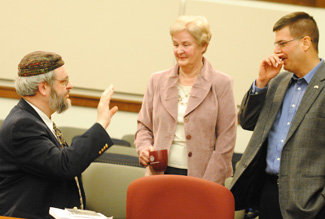Washtenaw County board of commissioners working session (Feb. 3, 2011): Last Thursday commissioners got a primer on the history of apportionment from county clerk Larry Kestenbaum, as background to the upcoming redistricting of the county board. Redistricting takes place every 10 years, keyed to U.S. Census results.

Washtenaw County clerk Larry Kestenbaum, left, talks with county commissioners Leah Gunn and Dan Smith at the board's Feb. 3 working session. (Photos by the writer.)
When block-by-block data is released from the 2010 census next month, Kestenbaum will convene a five-member apportionment commission that will craft a plan to redraw district lines, based on population shifts. Currently there are 11 districts for the county board, including four in Ann Arbor.
For a county the size of Washtenaw, it’s possible to have as few as five districts, or as many as 21. Kestenbaum said he didn’t think it would be politically viable to talk about an increase in the number of commissioners. Maintaining the current number – or having fewer districts – would be the likely outcome, he said, but that’s a decision the apportionment commission will make, with public input.
Kestenbaum’s own political career has been influenced by redistricting. He served on the county board from 2000-2002, but decided not to run for reelection when redistricting landed him in the same district as fellow incumbent Democrat Leah Gunn. Instead, he ran for county clerk in 2004 and was elected to that position, winning re-election in 2008.
Prior to Kestenbaum’s presentation, the board heard from Roger Rayle during public commentary time. Rayle, a leader of Scio Residents for Safe Water, gave an update on the Pall-Gelman 1,4-dioxane plume, calling it “the gift that keeps on giving.” [Full Story]






